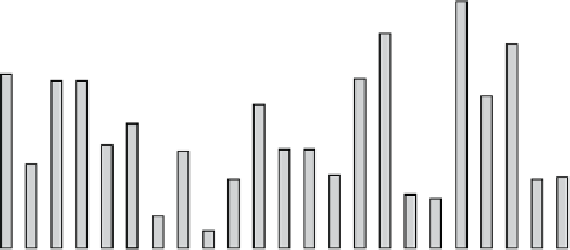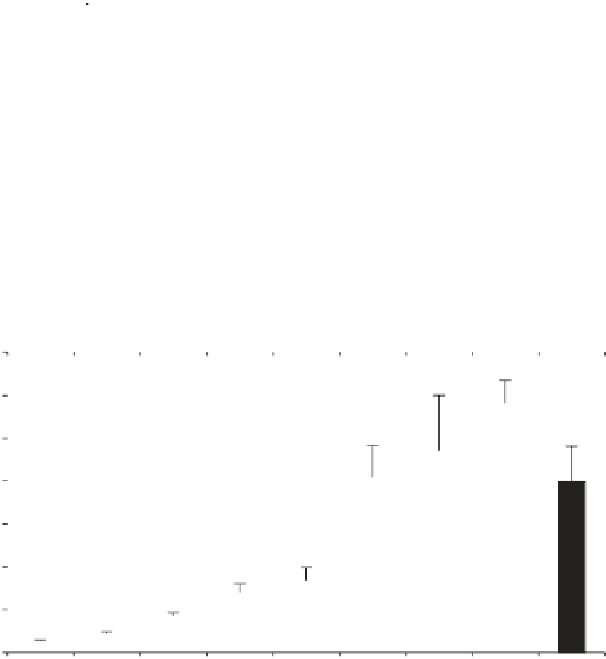Geology Reference
In-Depth Information
714 1
4
7 6 1
3
1
4
1
4
1
2
1
2
1
2
1
0
1
3
1
4
1
4
7 1
4
4 1
4
13
7
4
6
1
4
14
450
CaCO
3
(g m )
−
2
400
Amphibolis
sp.
A. griffithii
P. sinuosa
A. antarctica
Posidonia
sp.
P. australis
350
P. angustifolia
Other
300
CaCO
3
(g kg )
−
1
250
200
150
100
50
0
Fig. 12.
Average epiphyte abundance
from all sites studied. Values of CaCo
3
are in a g kg
-1
seagrass (grey bars) and
g m
-2
(coloured). Numbers at top of bars
refer to number of quadrats sampled at
each site, with locations at the bottom
given on Fig. 4. Data are grouped by
seagrass species.
n = 20
51
57
45
26
20
9
9
6
350
300
250
200
150
100
50
Fig. 13.
Relationship between epi-
phyte CaCO
3
and seagrass biomass.
Epiphyte CaCO
3
g m
2
by 100 g sea-
grass biomass bins.
0
0-99
100-199 200-299 300-399 400-499 500-599 600-699 700-799 800-899
Biomass (gm
−
2
-dry weight)
(Fig. 13) shows that calcareous epiphyte abundance
per unit area is closely associated with the
abundance of seagrass substrate (equivalent bio-
mass) available within that area. The fact that the
relationship is not linear indicates that some other
process is involved.
This exponential increase in epiphyte abun-
dance is herein attributed to the proximity of the
conspecifi c adults, reduced current velocity allow-
ing higher settlement, success rates, and light
availability below the canopy, which reduces com-
petition for space with non-calcareous epiphytes.
Epiphyte biomass is also patchy; where patchi-
ness of biomass is high, patchiness of epiphytes
is also high. The g kg
1
of seagrass data shows a
decrease in epiphyte abundance per shoot above a
biomass of 700 g m
2
(Fig. 13).
Greater abundance of calcareous epiphytes,
independent of seagrass biomass, is associ-
ated more with
Amphibolis
(238.5 g kg
1
) than
Posidonia
(127.2 g kg
1
) due to the accumulation
of calcareous epiphytes over time on the rela-
tively long-lived
Amphibolis
stems. This is con-
fi rmed by the Student's
t
-test (
P
0.001). These
results are similar to studies in Western Australia
(Lavery
et al
., 1998). It must also be remem-
bered that
Amphibolis
has the largest biomass of
epiphytic (calcareous and non-calcareous) organ-
isms of any species of seagrass (Borowitzka &
Lethbridge, 1989). There is also a correlation









































































































































































































